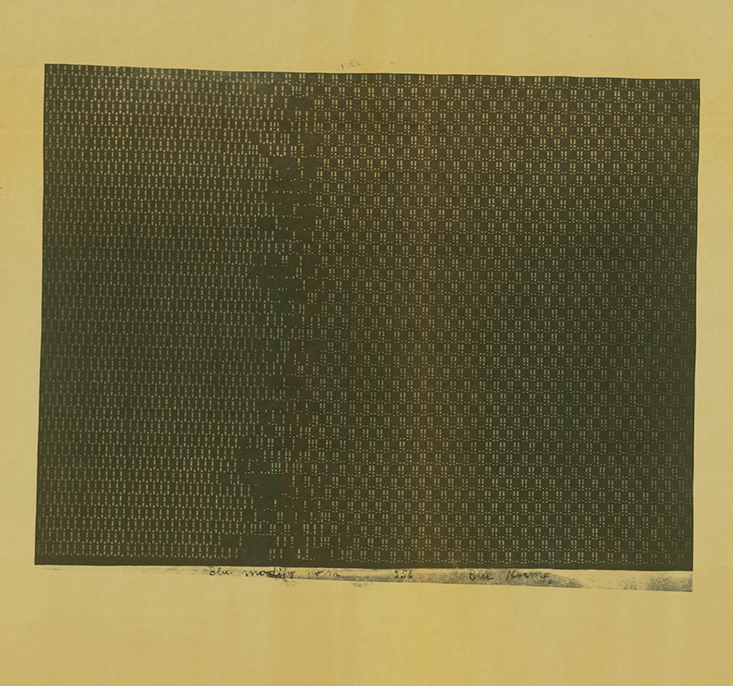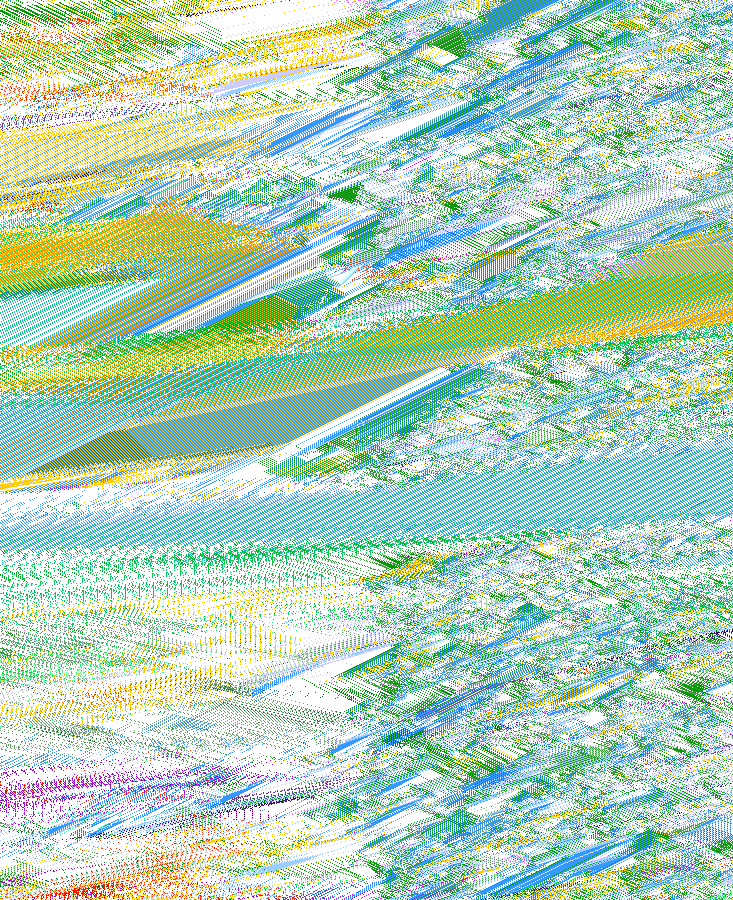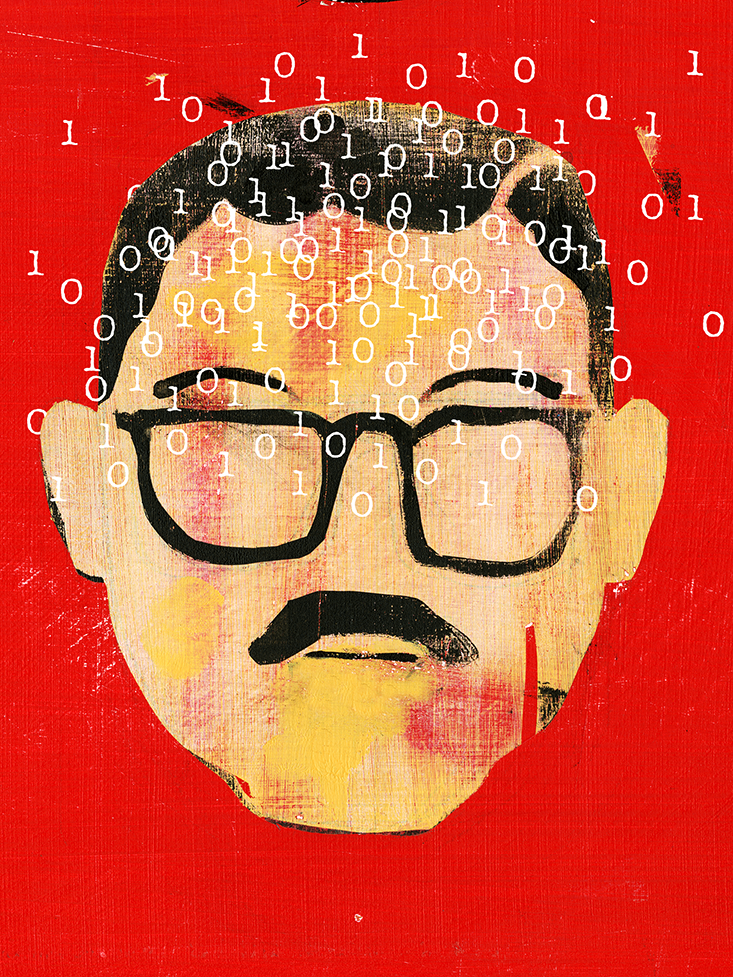In 1953, at the dawn of modern computing, Nils Aall Barricelli played God. Clutching a deck of playing cards in one hand and a stack of punched cards in the other, Barricelli hovered over one of the world’s earliest and most influential computers, the IAS machine, at the Institute for Advanced Study in Princeton, New Jersey. During the day the computer was used to make weather forecasting calculations; at night it was commandeered by the Los Alamos group to calculate ballistics for nuclear weaponry. Barricelli, a maverick mathematician, part Italian and part Norwegian, had finagled time on the computer to model the origins and evolution of life.
Inside a simple red brick building at the northern corner of the Institute’s wooded wilds, Barricelli ran models of evolution on a digital computer. His artificial universes, which he fed with numbers drawn from shuffled playing cards, teemed with creatures of code—morphing, mutating, melting, maintaining. He created laws that determined, independent of any foreknowledge on his part, which assemblages of binary digits lived, which died, and which adapted. As he put it in a 1961 paper, in which he speculated on the prospects and conditions for life on other planets, “The author has developed numerical organisms, with properties startlingly similar to living organisms, in the memory of a high speed computer.” For these coded critters, Barricelli became a maker of worlds.
Until his death in 1993, Barricelli floated between biological and mathematical sciences, questioning doctrine, not quite fitting in. “He was a brilliant, eccentric genius,” says George Dyson, the historian of technology and author of Darwin Among The Machines and Turing’s Cathedral, which feature Barricelli’s work. “And the thing about geniuses is that they just see things clearly that other people don’t see.”
Barricelli programmed some of the earliest computer algorithms that resemble real-life processes: a subdivision of what we now call “artificial life,” which seeks to simulate living systems—evolution, adaptation, ecology—in computers. Barricelli presented a bold challenge to the standard Darwinian model of evolution by competition by demonstrating that organisms evolved by symbiosis and cooperation.
Pixar cofounder Alvy Ray Smith says Barricelli influenced his earliest thinking about the possibilities for computer animation.
In fact, Barricelli’s projects anticipated many current avenues of research, including cellular automata, computer programs involving grids of numbers paired with local rules that can produce complicated, unpredictable behavior. His models bear striking resemblance to the one-dimensional cellular automata—life-like lattices of numerical patterns—championed by Stephen Wolfram, whose search tool Wolfram Alpha helps power the brain of Siri on the iPhone. Nonconformist biologist Craig Venter, in defending his creation of a cell with a synthetic genome—“the first self-replicating species we’ve had on the planet whose parent is a computer”—echoes Barricelli.
Barricelli’s experiments had an aesthetic side, too. Uncommonly for the time, he converted the digital 1s and 0s of the computer’s stored memory into pictorial images. Those images, and the ideas behind them, would influence computer animators in generations to come. Pixar cofounder Alvy Ray Smith, for instance, says Barricelli stirred his earliest thinking about the possibilities for computer animation, and beyond that, his philosophical muse. “What we’re really talking about here is the notion that living things are computations,” he says. “Look at how the planet works and it sure does look like a computation.”
Despite Barricelli’s pioneering experiments, barely anyone remembers him. “I have not heard of him to tell you the truth,” says Mark Bedau, professor of humanities and philosophy at Reed College and editor of the journal Artificial Life. “I probably know more about the history than most in the field and I’m not aware of him.”
Barricelli was an anomaly, a mutation in the intellectual zeitgeist, an unsung hero who has mostly languished in obscurity for the past half century. “People weren’t ready for him,” Dyson says. That a progenitor has not received much acknowledgment is a failing not unique to science. Visionaries often arrive before their time. Barricelli charted a course for the digital revolution, and history has been catching up ever since.

Barricelli was born in Rome on Jan. 24, 1912. According to Richard Goodman, a retired microbiologist who met and befriended the mathematician in the 1960s, Barricelli claimed to have invented calculus before his tenth birthday. When the young boy showed the math to his father, he learned that Newton and Leibniz had preempted him by centuries. While a student at the University of Rome, Barricelli studied mathematics and physics under Enrico Fermi, a pioneer of quantum theory and nuclear physics. A couple of years after graduating in 1936, he immigrated to Norway with his recently divorced mother and younger sister.
As World War II raged, Barricelli studied. An uncompromising oddball who teetered between madcap and mastermind, Barricelli had a habit of exclaiming “Absolut!” when he agreed with someone, or “Scandaloos!” when he found something disagreeable. His accent was infused with Scandinavian and Romantic pronunciations, making it occasionally challenging for colleagues to understand him. Goodman recalls one of his colleagues at the University of California, Los Angeles who just happened to be reading Barricelli’s papers “when the mathematician himself barged in and, without ceremony, began rattling off a stream of technical information about his work on phage genetics,” a science that studies gene mutation, replication, and expression through model viruses. Goodman’s colleague understood only fragments of the speech, but realized it pertained to what he had been reading.
“Are you familiar with the work of Nils Barricelli?” he asked.
“Barricelli! That’s me!” the mathematician cried.
Notwithstanding having submitted a 500-page dissertation on the statistical analysis of climate variation in 1946, Barricelli never completed his Ph.D. Recalling the scene in the movie Amadeus in which the Emperor of Austria commends Mozart’s performance, save for there being “too many notes,” Barricelli’s thesis committee directed him to slash the paper to a tenth of the size, or else it would not accept the work. Rather than capitulate, Barricelli forfeited the degree.
Barricelli began modeling biological phenomena on paper, but his calculations were slow and limited. He applied to study in the United States as a Fulbright fellow, where he could work with the IAS machine. As he wrote on his original travel grant submission in 1951, he sought “to perform numerical experiments by means of great calculating machines,” in order to clarify, through mathematics, “the first stages of evolution of a species.” He also wished to mingle with great minds—“to communicate with American statisticians and evolution-theorists.” By then he had published papers on statistics and genetics, and had taught Einstein’s theory of relativity. In his application photo, he sports a pyramidal moustache, hair brushed to the back of his elliptic head, and hooded, downturned eyes. At the time of his application, he was a 39-year-old assistant professor at the University of Oslo.
Although the program initially rejected him due to a visa issue, in early 1953 Barricelli arrived at the Institute for Advanced Study as a visiting member. “I hope that you will be finding Mr. Baricelli [sic] an interesting person to talk with,” wrote Ragnar Frisch, a colleague of Barricelli’s who would later win the first Nobel Prize in Economics, in a letter to John von Neumann, a mathematician at IAS, who helped devise the institute’s groundbreaking computer. “He is not very systematic always in his exposition,” Frisch continued, “but he does have interesting ideas.”

Centered above Barricelli’s first computer logbook entry at the Institute for Advanced Study, in handwritten pencil script dated March 3, 1953, is the title “Symbiogenesis problem.” This was his theory of proto-genes, virus-like organisms that teamed up to become complex organisms: first chromosomes, then cellular organs, onward to cellular organisms and, ultimately, other species. Like parasites seeking a host, these proto-genes joined together, according to Barricelli, and through their mutual aid and dependency, originated life as we know it.
Standard neo-Darwinian doctrine maintained that natural selection was the main means by which species formed. Slight variations and mutations in genes combined with competition led to gradual evolutionary change. But Barricelli disagreed. He pictured nimbler genes acting as a collective, cooperative society working together toward becoming species. Darwin’s theory, he concluded, was inadequate. “This theory does not answer our question,” he wrote in 1954, “it does not say why living organisms exist.”
Barricelli coded his numerical organisms on the IAS machine in order to prove his case. “It is very easy to fabricate or simply define entities with the ability to reproduce themselves, e.g., within the realm of arithmetic,” he wrote.
The early computer looked sort of like a mix between a loom and an internal combustion engine. Lining the middle region were 40 Williams cathode ray tubes, which served as the machine’s memory. Within each tube, a beam of electrons (the cathode ray) bombarded one end, creating a 32-by-32 grid of points, each consisting of a slight variation in electrical charge. There were five kilobytes of memory total stored in the machine. Not much by today’s standards, but back then it was an arsenal.
Barricelli saw his computer organisms as a blueprint of life—on this planet and any others.
Inside the device, Barricelli programmed steadily mutable worlds each with rows of 512 “genes,” represented by integers ranging from negative to positive 18. As the computer cycled through hundreds and thousands of generations, persistent groupings of genes would emerge, which Barricelli deemed organisms. The trick was to tweak his manmade laws of nature—“norms,” as he called them—which governed the universe and its entities just so. He had to maintain these ecosystems on the brink of pandemonium and stasis. Too much chaos and his beasts would unravel into a disorganized shamble; too little and they would homogenize. The sweet spot in the middle, however, sustained life-like processes.
Barricelli’s balancing act was not always easygoing. His first trials were riddled with pests: primitive, often single numeric genes invaded the space and gobbled their neighbors. Typically, he was only able to witness a couple of hereditary changes, or a handful at best, before the world unwound. To create lasting evolutionary processes, he needed to handicap these pests’ ability to rapidly reproduce. By the time he returned to the Institute in 1954 to begin a second round of experiments, Barricelli made some critical changes. First, he capped the proliferation of the pests to once per generation. That constraint allowed his numerical organisms enough leeway to outpace the pests. Second, he began employing different norms to different sections of his universes. That forced his numerical organisms always to adapt.
Even in the earlier universes, Barricelli realized that mutation and natural selection alone were insufficient to account for the genesis of species. In fact, most single mutations were harmful. “The majority of the new varieties which have shown the ability to expand are a result of crossing-phenomena and not of mutations, although mutations (especially injurious mutations) have been much more frequent than hereditary changes by crossing in the experiments performed,” he wrote.
When an organism became maximally fit for an environment, the slightest variation would only weaken it. In such cases, it took at least two modifications, effected by a cross-fertilization, to give the numerical organism any chance of improvement. This indicated to Barricelli that symbioses, gene crossing, and “a primitive form of sexual reproduction,” were essential to the emergence of life.
“Barricelli immediately figured out that random mutation wasn’t the important thing; in his first experiment he figured out that the important thing was recombination and sex,” Dyson says. “He figured out right away what took other people much longer to figure out.” Indeed, Barricelli’s theory of symbiogenesis can be seen as anticipating the work of independent-thinking biologist Lynn Margulis, who in the 1960s showed that it was not necessarily genetic mutations over generations, but symbiosis, notably of bacteria, that produced new cell lineages.
Barricelli saw his computer organisms as a blueprint of life—on this planet and any others. “The question whether one type of symbio-organism is developed in the memory of a digital computer while another type is developed in a chemical laboratory or by a natural process on some planet or satellite does not add anything fundamental to this difference,” he wrote. A month after Barricelli began his experiments on the IAS machine, Crick and Watson announced the shape of DNA as a double helix. But learning about the shape of biological life didn’t put a dent in Barricelli’s conviction that he had captured the mechanics of life on a computer. Let Watson and Crick call DNA a double helix. Barricelli called it “molecule-shaped numbers.”

What buried Barricelli in obscurity is something of a mystery. “Being uncompromising in his opinions and not a team player,” says Dyson, no doubt led to Barricelli’s “isolation from the academic mainstream.” Dyson also suspects Barricelli and the indomitable Hungarian mathematician von Neumann, an influential leader at the Institute of Advanced Study, didn’t hit it off. Von Neumann appears to have ignored Barricelli. “That was sort of fatal because everybody looked to von Neumann as the grandfather of self-replicating machines.”
Ever so slowly, though, Barricelli is gaining recognition. That stems in part from another of Barricelli’s remarkable developments; certainly one of his most beautiful. He didn’t rest with creating a universe of numerical organisms, he converted his organisms into images. His computer tallies of 1s and 0s would then self-organize into visual grids of exquisite variety and texture. According to Alexander Galloway, associate professor in the department of media, culture, and communication at New York University, a finished Barricelli “image yielded a snapshot of evolutionary time.”
When Barricelli printed sections of his digitized universes, they were dazzling. To modern eyes they might look like satellite imagery of an alien geography: chaotic oceans, stratigraphic outcrops, and the contours of a single stream running down the center fold, fanning into a delta at the patchwork’s bottom. “Somebody needs to do a museum show and show this stuff because they’re outrageous,” Galloway says.
Barricelli was an uncompromising oddball who teetered between madcap and mastermind.
Today, Galloway, a member of Barricelli’s small but growing cadre of boosters, has recreated the images. Following methods described by Barricelli in one of his papers, Galloway has coded an applet using the computer language Processing to revive Barricelli’s numerical organisms—with slight variation. While Barricelli encoded his numbers as eight-unit-long proto-pixels, Galloway condensed each to a single color-coded cell. By collapsing each number into a single pixel, Galloway has been able to fit eight times as many generations in the frame. These revitalized mosaics look like psychedelic cross-sections of the fossil record. Each swatch of color represents an organism, and when one color field bumps up against another one, that’s where cross-fertilization takes place.
“You can see these kinds of points of turbulence where the one color meets another color,” Galloway says, showing off the images on a computer in his office. “That’s a point where a number would be—or a gene would be—sort of jumping from one organism to another.” Here, in other words, is artificial life—Barricelli’s symbiogenesis—frozen in amber. And cyan and lavender and teal and lime and fuchsia.
Galloway is not the only one to be struck by the beauty of Barricelli’s computer-generated digital images. As a doctoral student, Pixar cofounder Smith became familiar with Barricelli’s work while researching the history of cellular automata for his dissertation. When he came across Barricelli’s prints he was astonished. “It was remarkable to me that with such crude computing facilities in the early 50s, he was able to be making pictures,” Smith says. “I guess in a sense you can say that Barricelli got me thinking about computer animation before I thought about computer animation. I never thought about it that way, but that’s essentially what it was.”
Cyberspace now swells with Barricelli’s progeny. Self-replicating strings of arithmetic live out their days in the digital wilds, increasingly independent of our tampering. The fittest bits survive and propagate. Researchers continue to model reduced, pared-down versions of life artificially, while the real world bursts with Boolean beings. Scientists like Venter conjure synthetic organisms, assisted by computer design. Swarms of autonomous codes thrive, expire, evolve, and mutate underneath our fingertips daily. “All kinds of self-reproducing codes are out there doing things,” Dyson says. In our digital lives, we are immersed in Barricelli’s world.
Robert Hackett is a science, technology, and business reporter for Fortune magazine. @rhhackett






























